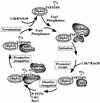RNA polymerase II carboxy-terminal domain kinases: emerging clues to their function
- PMID: 12455950
- PMCID: PMC118035
- DOI: 10.1128/EC.1.2.153-162.2002
RNA polymerase II carboxy-terminal domain kinases: emerging clues to their function
Figures

Similar articles
-
Role of RNA polymerase II carboxy terminal domain phosphorylation in DNA damage response.J Microbiol. 2005 Dec;43(6):516-22. J Microbiol. 2005. PMID: 16410768
-
Phosphorylation of the RNA polymerase II carboxy-terminal domain by the Bur1 cyclin-dependent kinase.Mol Cell Biol. 2001 Jul;21(13):4089-96. doi: 10.1128/MCB.21.13.4089-4096.2001. Mol Cell Biol. 2001. PMID: 11390638 Free PMC article.
-
Cell cycle regulation and RNA polymerase II.Front Biosci. 2000 Feb 1;5:D244-57. doi: 10.2741/bregman. Front Biosci. 2000. PMID: 10704151 Review.
-
A multiprotein mediator of transcriptional activation and its interaction with the C-terminal repeat domain of RNA polymerase II.Cell. 1994 May 20;77(4):599-608. doi: 10.1016/0092-8674(94)90221-6. Cell. 1994. PMID: 8187178
-
Regulation of RNA polymerase II activity by CTD phosphorylation and cell cycle control.J Cell Physiol. 2002 Feb;190(2):160-9. doi: 10.1002/jcp.10058. J Cell Physiol. 2002. PMID: 11807820 Review.
Cited by
-
BRD4 is an atypical kinase that phosphorylates serine2 of the RNA polymerase II carboxy-terminal domain.Proc Natl Acad Sci U S A. 2012 May 1;109(18):6927-32. doi: 10.1073/pnas.1120422109. Epub 2012 Apr 16. Proc Natl Acad Sci U S A. 2012. PMID: 22509028 Free PMC article.
-
Inhibition of the cyclin-dependent kinases at the beginning of human cytomegalovirus infection specifically alters the levels and localization of the RNA polymerase II carboxyl-terminal domain kinases cdk9 and cdk7 at the viral transcriptosome.J Virol. 2008 Jan;82(1):394-407. doi: 10.1128/JVI.01681-07. Epub 2007 Oct 17. J Virol. 2008. PMID: 17942543 Free PMC article.
-
Arabidopsis C-terminal domain phosphatase-like 1 and 2 are essential Ser-5-specific C-terminal domain phosphatases.Proc Natl Acad Sci U S A. 2004 Oct 5;101(40):14539-44. doi: 10.1073/pnas.0403174101. Epub 2004 Sep 23. Proc Natl Acad Sci U S A. 2004. PMID: 15388846 Free PMC article.
-
Separation of the Saccharomyces cerevisiae Paf1 complex from RNA polymerase II results in changes in its subnuclear localization.Eukaryot Cell. 2005 Jan;4(1):209-20. doi: 10.1128/EC.4.1.209-220.2005. Eukaryot Cell. 2005. PMID: 15643076 Free PMC article.
-
The C-terminal domain of pol II and a DRB-sensitive kinase are required for 3' processing of U2 snRNA.EMBO J. 2003 Feb 17;22(4):925-34. doi: 10.1093/emboj/cdg077. EMBO J. 2003. PMID: 12574128 Free PMC article.
References
-
- Akoulitchev, S., S. Chuikov, and D. Reinberg. 2000. TFIIH is negatively regulated by cdk8-containing mediator complexes. Nature 407:102-106. - PubMed
-
- Akoulitchev, S., T. P. Makela, R. A. Weinberg, and D. Reinberg. 1995. Requirement for TFIIH kinase activity in transcription by RNA polymerase II. Nature 377:557-560. - PubMed
-
- Allison, L. A., M. Moyle, M. Shales, and C. J. Ingles. 1985. Extensive homology among the largest subunits of eukaryotic and prokaryotic RNA polymerases. Cell 42:599-610. - PubMed
-
- Allison, L. A., J. K. Wong, V. D. Fitzpatrick, M. Moyle, and C. J. Ingles. 1988. The C-terminal domain of the largest subunit of RNA polymerase II of Saccharomyces cerevisiae, Drosophila melanogaster, and mammals: a conserved structure with an essential function. Mol. Cell. Biol. 8:321-329. - PMC - PubMed
-
- Archambault, J., R. S. Chambers, M. S. Kobor, Y. Ho, M. Cartier, D. Bolotin, B. Andrews, C. M. Kane, and J. Greenblatt. 1997. An essential component of a C-terminal domain phosphatase that interacts with transcription factor IIF in Saccharomyces cerevisiae. Proc. Natl. Acad. Sci. USA 94:14300-14305. - PMC - PubMed
Publication types
MeSH terms
Substances
Grants and funding
LinkOut - more resources
Full Text Sources
Molecular Biology Databases

